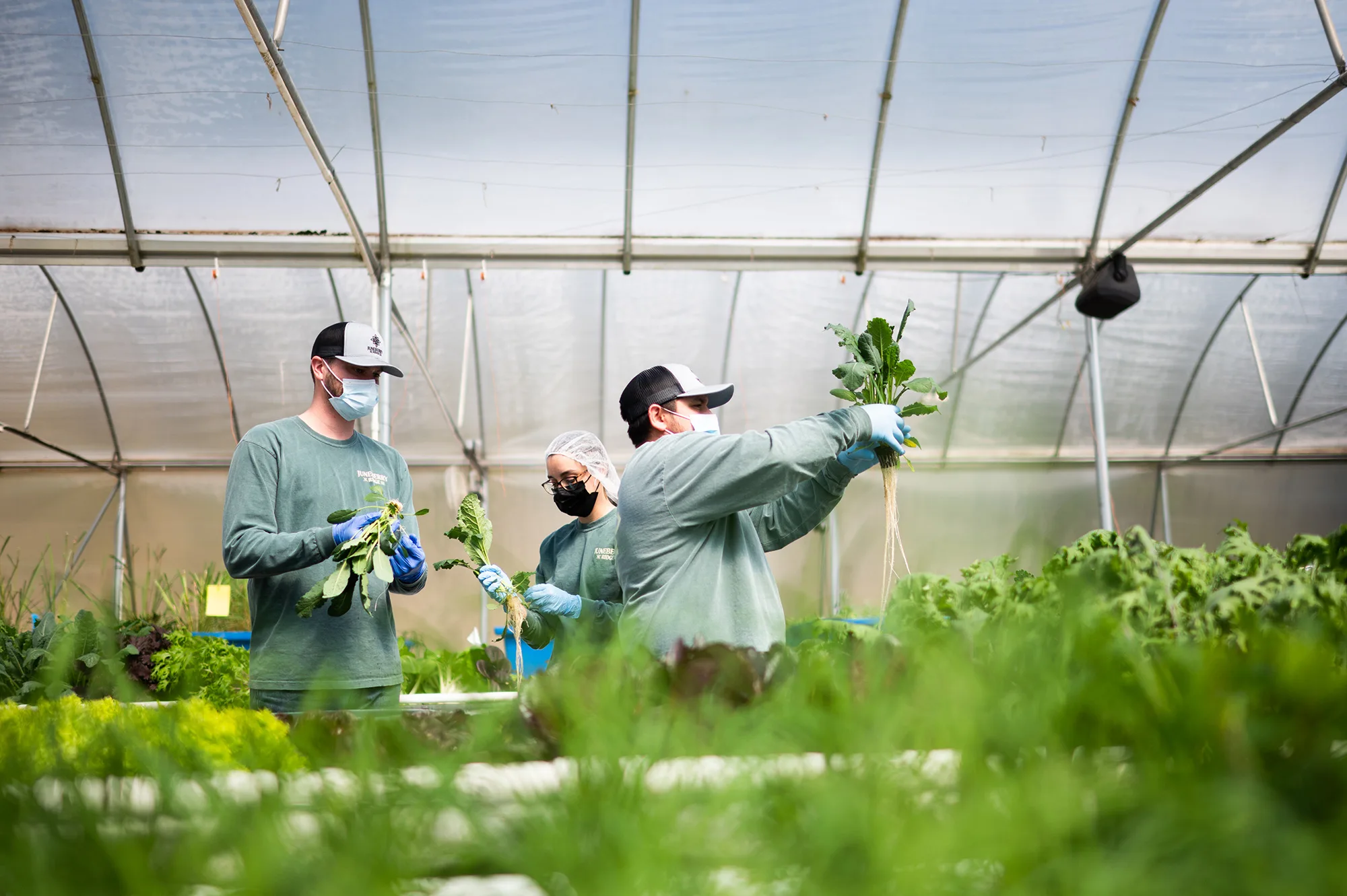The promise of aquaponics was big when our operation was small.
As Lucky Clays Farms (the precursor to Juneberry Ridge), we embraced aquaponics as an essential tool in bringing our vision to life. It’s easy to see the appeal. The health of our ocean ecosystem is strained, yet the demand for fish and fresh produce is always rising. Aquaponics is an attractive solution for producing a great variety of quality foods, both plants and fish, and in proximity to the people who need them.
Variety and quality is exactly what aquaponics delivered for us, on a small scale.
It started with a relatively small 4,600 square foot, culinary-focused aquaponics greenhouse. We set it up with integrated management techniques including indicator plants, trap crops, beneficial insects, culling, polyculture, and banker plants – all sustainable practices that produced a healthy variety of robust plants and tilapia.

As our small operation thrived, the output was exciting.
We were supplying 13 restaurants – chefs who loved our local story and delighted in the wide selection of delicious food we could offer them. We worked closely with creative local chefs like Clark Barlowe. He was the owner and head chef at Heirloom from 2014 to 2019. He and others collaborated with us to curate farm-to-table products for their patrons.
At its peak, our small greenhouse was capable of producing ~7,000 units per month that included a range of vibrant flavor and color profiles:
- 13 varieties of lettuce
- 6 types of basil
- 4 kinds of arugula
- 3 options for kale
- 3 choices of bok choy
- 12 additional herbs
- 26 different microgreens
- We even had room for experiments, such as edible flowers that introduced flavor combinations that could change how people think about food.
 Nasturtium: A bright flavor to match a vivid appearance.
Nasturtium: A bright flavor to match a vivid appearance.
Among the edible flowers produced in our greenhouse, nasturtium is one that continues to win fans with its vibrant colors and a peppery flavor that is just as bright. Its leaf is a perfect complement to seafood, and many of us love how it tastes in a salad or on a burger. The Badin Treehouse, a restaurant here in Stanly County, started buying these flowers by the hundreds in 2018. They were serious about their cakes and wanted an alternative to the metallic taste of conventional food colorings; our nasturtiums gave them exactly that.
A taste of success made us want to share it wider.
Having seen that the variety and flavor from our small greenhouse could be so successful, we chose to scale up the operation and bring these same experiences to people shopping in grocery stores. We set up a greenhouse 10 times as large as that first one – a full acre in size (43,000 sqft.). We won a contract with a major chain and began delivering to 13 high-volume stores in Charlotte. This contract utilized about half of our commercial scale greenhouse for aquaponics at (21,500 sqft.). Grocery managers knew customers would be drawn to our local, sustainably sourced produce. We set up test displays with a wide variety of leafy greens and lettuces. We were determined to give shoppers new foods to discover.
Instead, we were the ones making an unexpected discovery.
Our market tests showed that the customers wanted a consistent, dependable supply of a very narrow selection of plants – and there was demand for a great quantity of just that. Our 41,000 units per month production capacity rapidly became composed of just three single varieties of butterhead lettuce, chives, and basil. These were popular, and they sold well – to keep up with the demand, we moved away from sustainable polyculture, and drifted into monoculture production.

Monoculture became a beast we had to feed. We stopped letting nature lead.
Without healthy polyculture to keep pests in check and allow a mix of plants to support each other, we had to resort to other methods to manage pests and prevent blights. To keep our production up, we found ourselves falling short of our ideological standards. Historically anytime we used pesticides they were OMRI (Organic Material Review Institute) approved. However, in this new chapter of monoculture production we found ourselves dependent upon conventional pesticides for commercial greenhouses. These practices went against what we stood for. This was not changing the way the world grows. As proud as we were of what we had achieved with aquaponics, I am even more proud of what we did next: we let it collapse. When we eliminated the external inputs like pesticides, the large monoculture system couldn’t keep going.
Today, we are our own customer for an aquaponics output that makes us proud.
We are back to producing a wide variety to meet the needs of our own chefs. Beyond the food that our greenhouse delivers to the kitchen, we also sell produce at farmers’ markets and to neighbors who come buy from us directly via our Toast App for online orders. (one of our favorites is Mr. Charlie, who must really love salad – he buys at least 6 heads of lettuce from us each week). We have other outputs that we value as well. We still teach aquaponics, and the educational tours often open people’s eyes to new possibilities in food production. The lessons of aquaponics are as important as the food. And we are still learning.
We’re on a quest to change the way the world grows.
We like to envision a world of the future where people can get all the food they need from local farms – wide varieties of fruits, vegetables, nuts, grains, meats and fish all growing nearby, bountiful, flavorful, and healthy. It’s a grand vision and we know that it’s not a simple one to bring about. Getting there will mean trying different ways of producing food, paying attention to what works and what doesn’t, and being willing to adapt as we grow.
What’s next?
We’re continuing to discover new ways to utilize our 43,000 sqft. greenhouse, and we’re stepping out from its walls to establish an in-ground kitchen garden. To do that, we’re enlisting the help of chickens to regenerate topsoil on a half-acre plot behind the greenhouse. Stay tuned for more on that story.

Subscribe to our newsletter for more posts about the farm, our pursuits in regenerative agriculture, and all our events here at Juneberry Ridge. If you’re considering hosting a private event, planning a wedding, or looking for any reason to escape into nature, contact our events team here. You can also order fresh produce from our greenhouse, along with ready-to-eat meals online via our Toast App.
Please also share your thoughts and questions with us, we can’t wait to hear from you.


